Tiny yet powerful lynx spiders are effective predators of insects in the garden. Concealed in foliage or flowers they are skilled hunters and their name refers to their catlike hunting abilities.
Although they are mostly ambush hunters they can move fast and some species of lynx spider actively stalk their prey and they have the ability to jump to catch flying insects. Although they do produce silken threads, they do not build webs to trap prey.
The lynx spiders I see amongst foliage or on flowers typically don’t run away when approached, but rather they tend to sidle off to the underside of a leaf or petal to hide if I approach too close or too suddenly.
The first time I took real notice of the tiny lynx spiders in our garden was when I noticed one sitting on a leaf in the African dog rose tree (Xylotheca kraussiana). I got into the habit of going to check on it every day to find it always motionless on the same leaf, and as the days went by its favoured leaf became discoloured, developing an autumnal patch where the spider habitually perched.
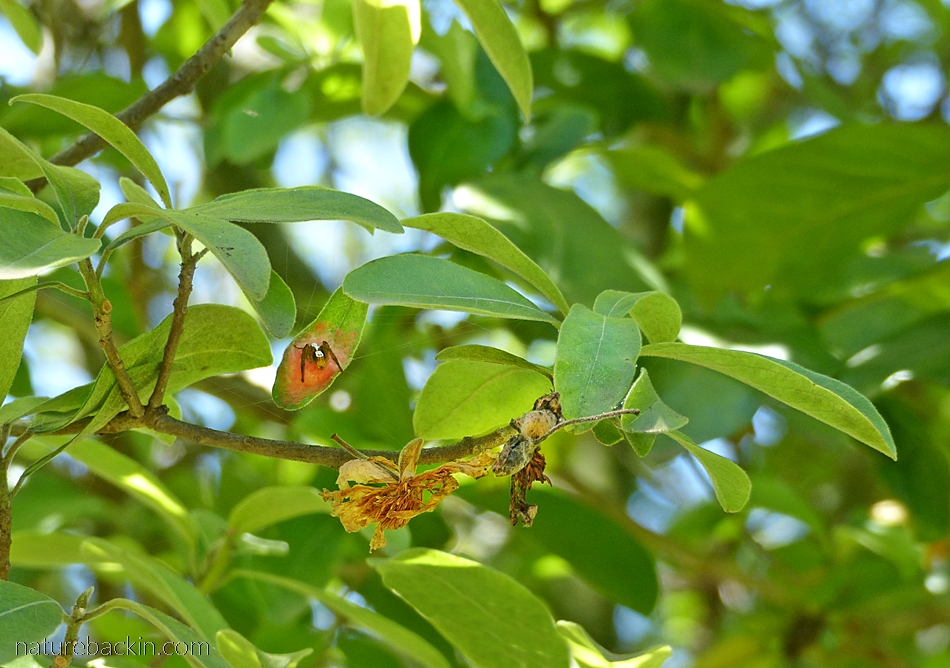
A lynx spider sitting on its favoured leaf, keeping an eye on its purse of eggs constructed in the dry leaf and flower below its watching place
In time I realised that the spider was keeping watch over an egg purse that it had made from a leaf and part of a flower, which had dried and were attached to a twig below where it kept watch. Eventually, one morning I saw that tiny spiderlings had hatched and were leaving the egg purse and dispersing to hide under the nearby leaves.
The scientific name for lynx spiders is Oxyopidae, derived from Greek and meaning sharp sighted. The spider in these photos is so small that although the eyes are visible, I was not able to count that it has 8 eyes, with 4 eyes arranged in an arc curving over the 2 largest central eyes, with 2 smaller eyes below those. The eyes are at the top of the flattish plane on the front of the ‘face’. In these spiders the head and the thorax are fused into one, with the abdomen being distinct.
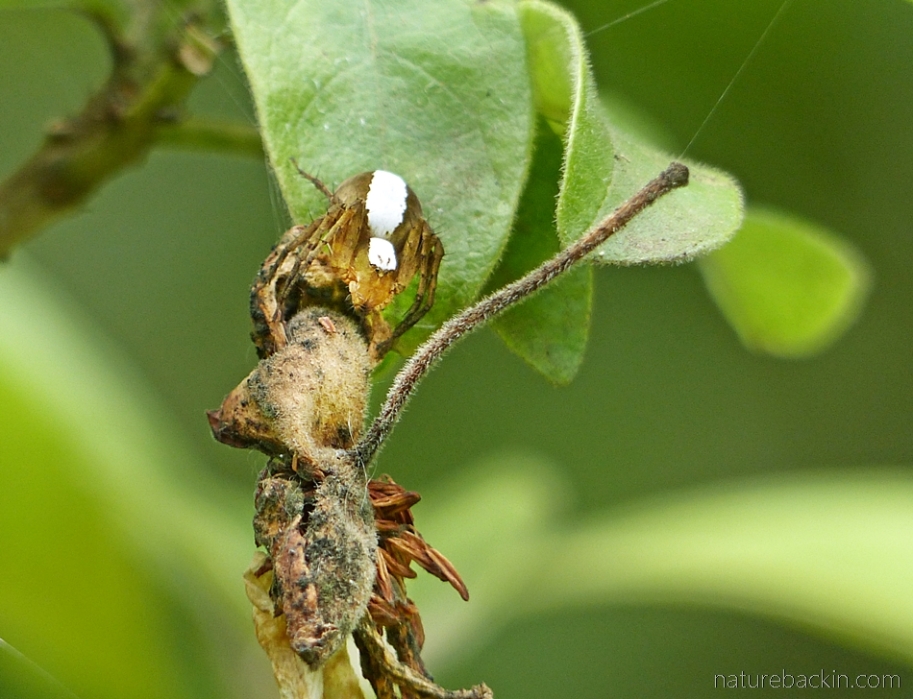
One morning I found the lynx spider had come down to check on her egg pouch. It appears that she has used silk threads to attach the pouch to a green leaf
Even after the baby spiders had dispersed and the female spider had abandoned her perching leaf I continued to look out for lynx spiders on the African dog rose. One day I spotted a lynx spider on a withered flower with a bee that it had caught.
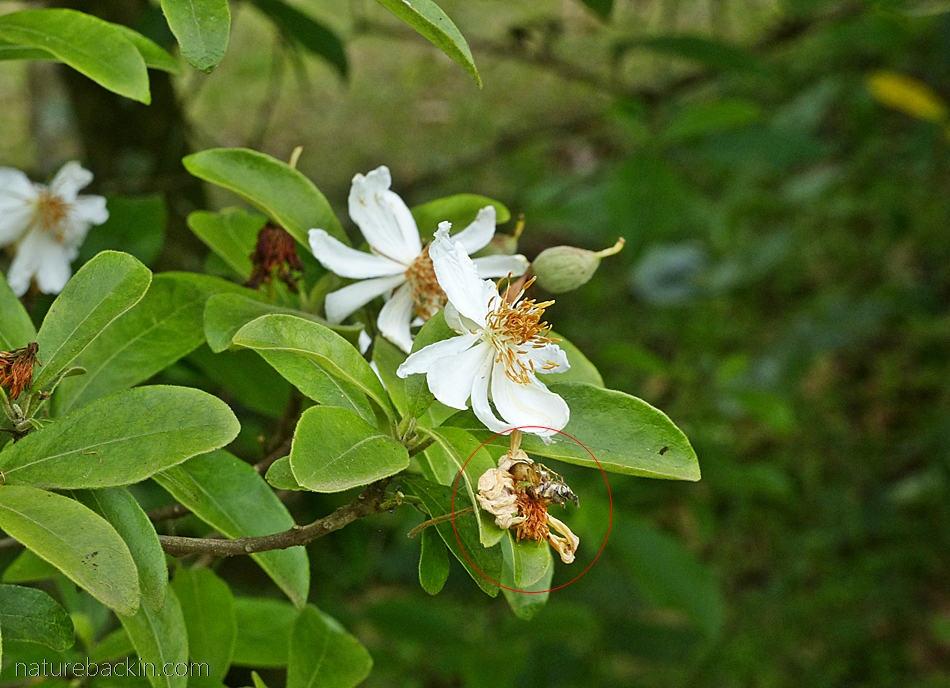
To provide a sense of scale, this is a longer shot of the spider with its prey in the dog rose. It is ringed by a red circle to make it easier to spot
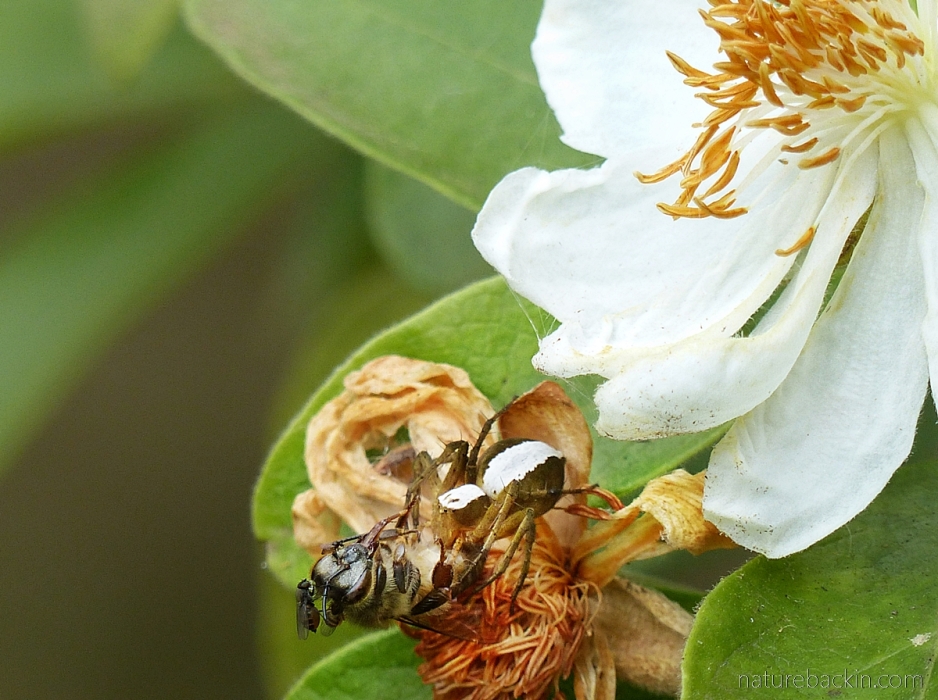
Here is a closer shot of the lynx spider with its bee prey. The dying bee attracted the attention of jackal flies that arrived to join the spider in its meal
Jackal flies, also known as freeloader flies, belong to the Milichiidae family. The small flies are thought to be attracted by an alarm pheromone given off by the dying bee.
Lynx spiders have spiny bristles on their legs. These bristles help the spiders trap their prey and also serve to protect the spiders from being hurt by struggling prey.
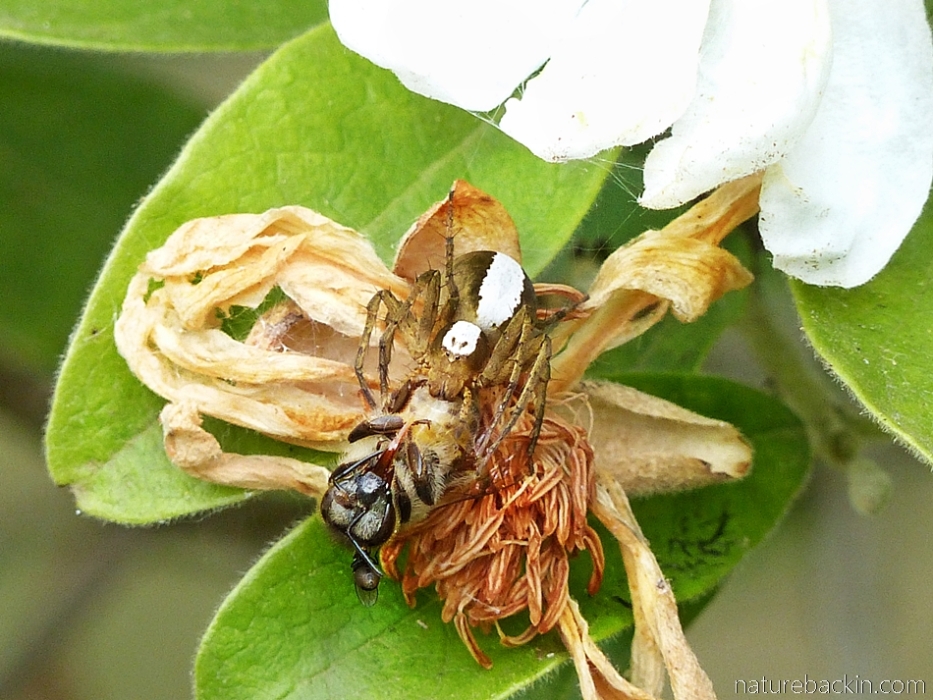
A close-up of the lynx spider – the spines on its legs can just be seen. The dead bee is lying on its back with its tongue protruding
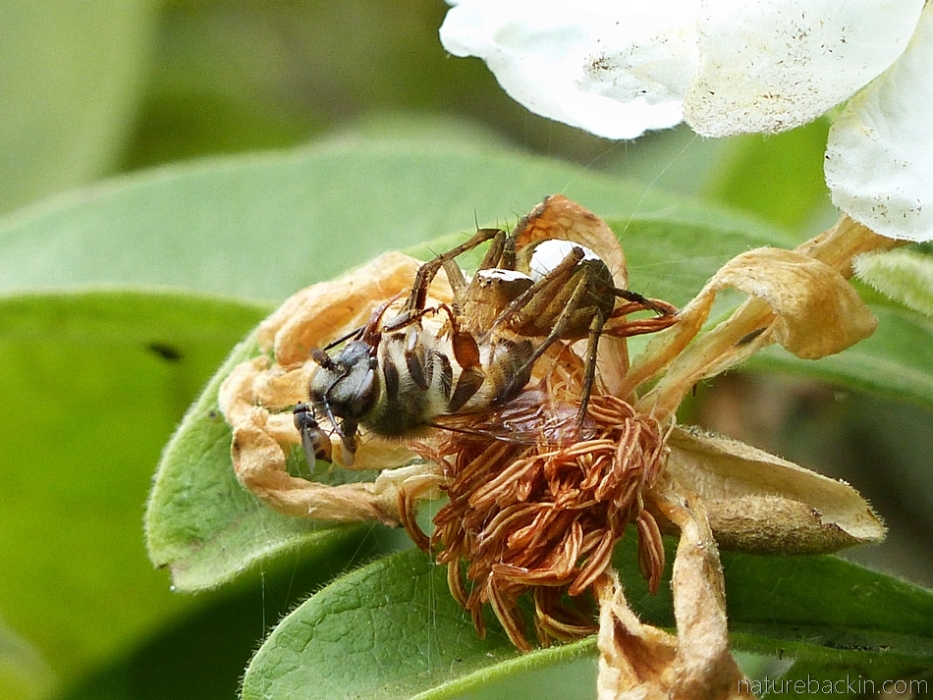
Lynx spiders have venom that they use to immobilise and kill their prey. Lynx spiders in South Africa are harmless to humans
All species of Lynx spiders are active during the day. In South Africa there are three genera of lynx spiders. Oxyopes, meaning quick footed, are golden or grass lynx spiders. Species in this genus tend to be very active hunters, searching for and stalking prey and with the ability to pounce or jump to catch prey. Peucetia are green lynx spiders that hunt in plants with viscid hairs that trap prey. The spider avoids being trapped itself by laying down silken threads along which it walks or else it hangs from its silk threads with its hind legs, using its spiny foremost legs as a basket with which to capture the prey. The third genus is Hamataliwa comprising dome-headed lynx spiders, and they resemble crab spiders in hunting technique. Mimicking a knot, bud or thorn in the vegetation they are mostly ambush hunters (Source: Biodiversity Explorer).
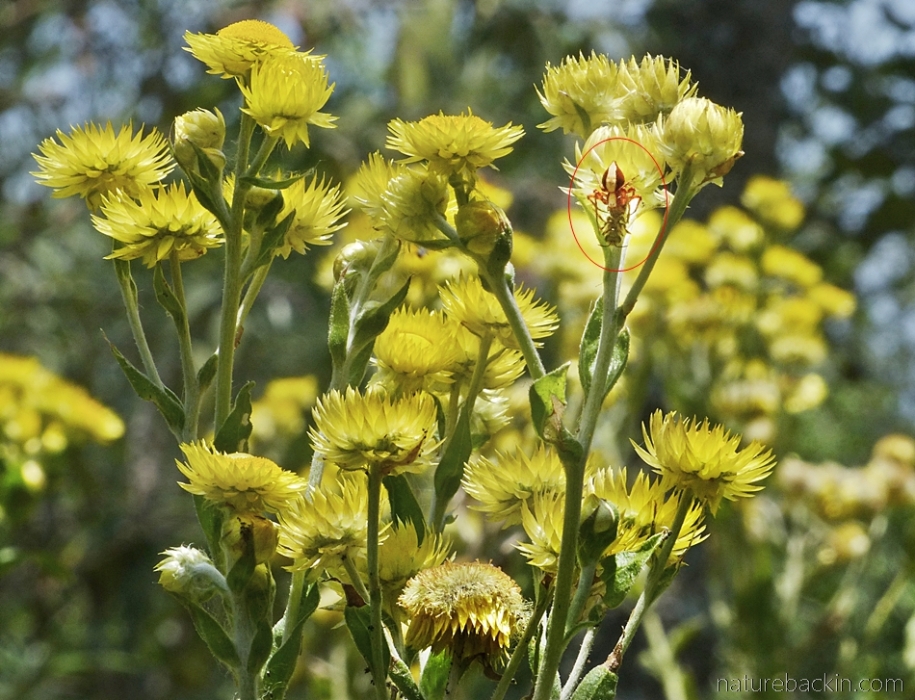
One bright morning I noticed a lynx spider in the everlasting (Helichrysum cooperi) after it had caught a bee. Because of its small size I have added a red circle to make it easier to locate the spider in the photo

By staying motionless in a flower and waiting to catch any hapless pollinator that visits, this spider succeeded in catching a bee
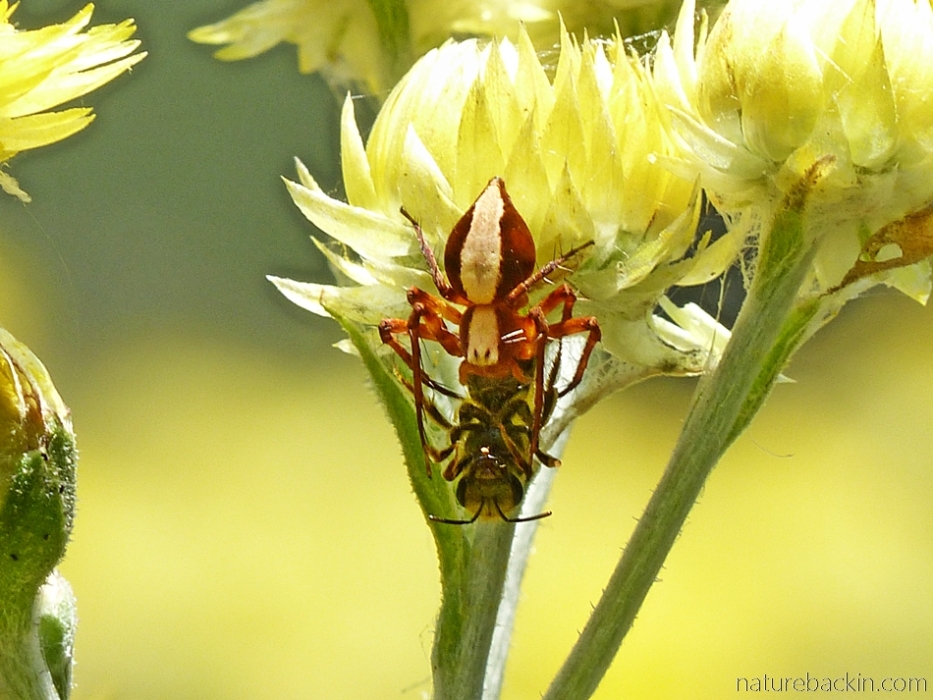
This lynx spider is redder in colour than the spider I saw in the dog rose, but it has the same band of creamy white down the length of its body. It is holding the motionless bee that is upsidedown

The spider has reoriented the bee and now grasps it at its head
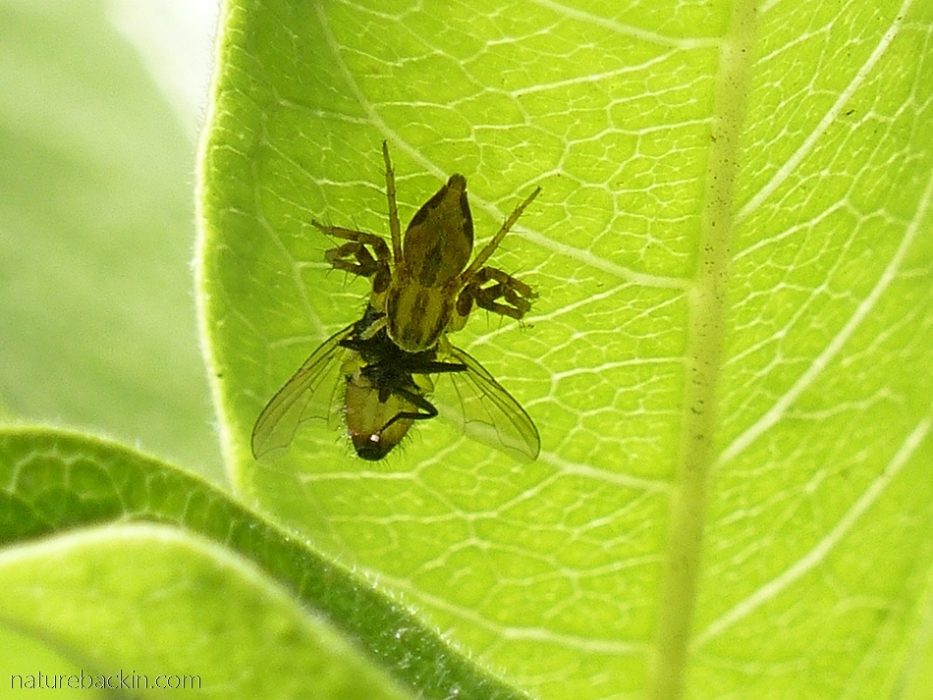
I managed to photograph an even tinier species of lynx spider on the underside of a leaf while it sucks fluid from its fly prey
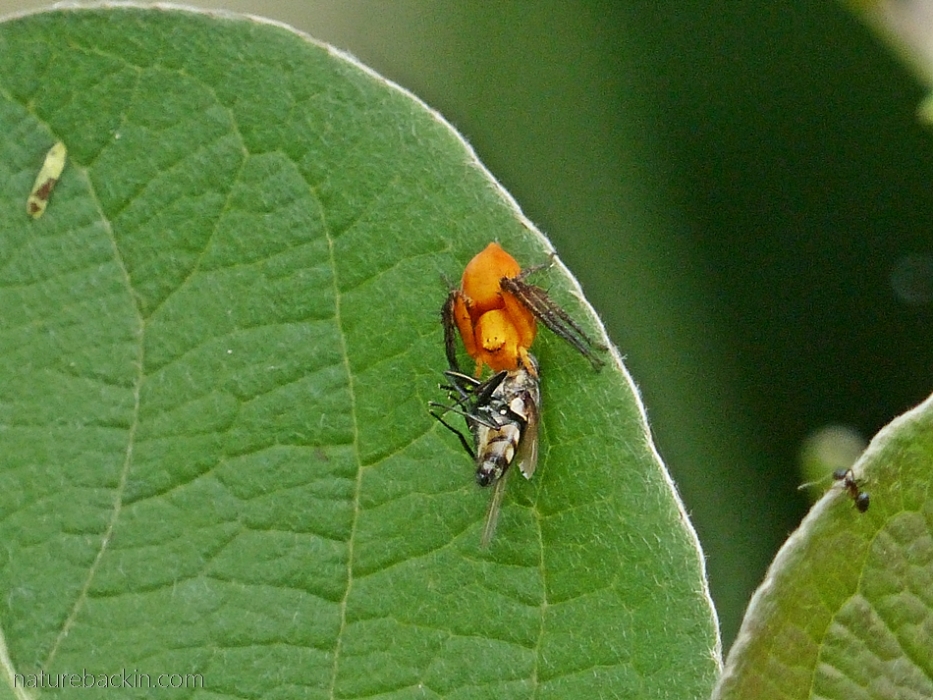
And even tinier still is this orange lynx spider, also with a fly. The rather blurry ant on the right-hand side perhaps provides a clue as to just how small this spider is – rather too small in fact for a sharp photograph taken using the zoom lens. I have not mastered the art of approaching close enough to take a macro shot without frightening the spider into hiding
Although not all 9 genera of lynx spiders are represented throughout the world, at least some species of lynx spiders occur across all continents. So next time you are out and about in a garden, park or natural environment keep an eye out for these intriguing little predators.
Sources:
Larson, Norman. [n.d.] Family: Oxyopidae (lynx spiders). https://www.biodiversityexplorer.info/arachnids/spiders/oxyopidae/index.htm; Picker, Mike, Griffiths, Charles & Weaving, Alan. 2019. Field Guide to Insects of South Africa. Cape Town: Struik Nature.; Wikipedia. [n.d.] Lynx spider. https://en.wikipedia.org/wiki/Lynx_spider
Posted by Carol

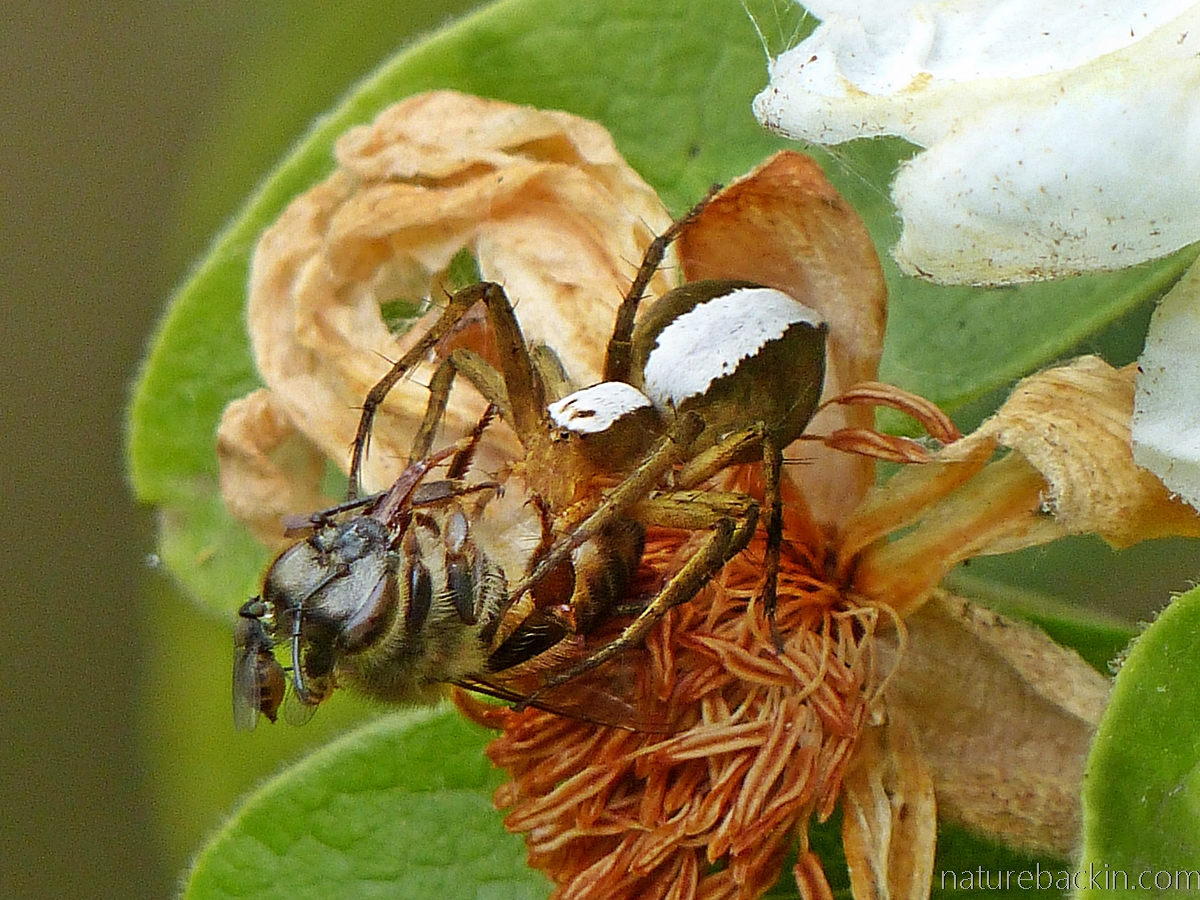







August 25, 2020 at 1:23 pm
Wow! Marvellous photography Carol and such fascinating information about these tiny creatures. Although they don’t look that small to me – I think they would be considered quite large over here!
LikeLiked by 1 person
August 27, 2020 at 1:19 pm
Thank you Sandra. They are interesting little predators. Re the size, the spider on the dog wood was slightly shorter in length than the honeybee – perhaps the legs make it appear larger than it is.
LikeLiked by 1 person
August 22, 2020 at 6:11 am
I love your blog, the smaller creatures always fascinate me, their part in our interconnected ‘web of life’! Thank you Carol! xxx
LikeLiked by 1 person
August 22, 2020 at 4:43 pm
Thanks Christeen. They certainly are fascinating and there is lots to learn and the interconnections are amazing too. xxx
LikeLiked by 1 person
August 21, 2020 at 11:39 pm
Carol, I thoroughly enjoyed this post. Such drama going on in the yard. Fascinating to read and view your excellent photos. You weave interesting facts into your storytelling in a very compelling way.
LikeLiked by 1 person
August 22, 2020 at 4:13 pm
Thanks very much Jane. Yes, despite the tiny scale, these are dramas going on out there.
LikeLiked by 1 person
August 21, 2020 at 7:00 pm
Fabulous photography, Carol! Interesting facts about this spider.
LikeLiked by 1 person
August 22, 2020 at 4:02 pm
Thanks very much Leya. I am learning as I go along 🙂 Nice to be able to share.
LikeLiked by 1 person
August 21, 2020 at 9:50 am
Congrats Carol, amazing info and once more, fantastic photography. Really learnt a lot this time!
LikeLiked by 1 person
August 22, 2020 at 3:59 pm
Thanks so much Suzette. It is remarkable that there is so much fascinating stuff to learn about even those tiny creatures that we are often unaware of.
LikeLike
August 21, 2020 at 8:53 am
A truly fascinating post, as meticulously researched and illustrated with your immaculate photographs, as always. The little spiders are clearly diligent and fearsome mothers; does the guarding of their eggs mean that they are vulnerable to predation? I found your observation of the arrival of flies to the site as the spider killed the bee particularly interesting as I’ve seen it similarly with crab spiders and their prey and wondered what it might be that attracted them; I hadn’t thought about alarm pheromones from the victim.
LikeLiked by 1 person
August 22, 2020 at 3:54 pm
Hi Theresa. Thanks very much. I have read that included in those that might predate on spider eggs are ants and even other spiders. Some species of lynx spiders may even move the egg purse or suspend it from threads in response to a threat to the eggs.
The fieldguide to SA insects referenced in my post is where I found the info re alarm pheromones from the victim.
In another level of fascination, some plants (flowers) mimic distress pheromones of specific species in order to attract flies as pollinators! See for example https://www.popsci.com/how-this-flower-dupes-flies-into-pollinating-it/
LikeLike
August 21, 2020 at 7:23 am
You are as sharp eyed as the lynx spider to have noticed it amongst the foliage. I have known since primary school that spiders have eight legs, but thanks to you have now learnt that some spiders have eight eyes too. Remarkable
LikeLiked by 1 person
August 21, 2020 at 8:38 pm
I am gradually discovering that spiders are remarkable in many ways. There are fascinating little worlds out there!
LikeLiked by 1 person
August 21, 2020 at 6:37 am
A fascinating account as are your wonderfully detailed photographs.
LikeLiked by 1 person
August 21, 2020 at 8:34 pm
Thanks very much Anne.
LikeLike
August 21, 2020 at 5:01 am
Great photos and descriptions of the spiders and their activities. I do find them fascinating though feel a bit sad for the bees, especially given all that they’re up against, but that’s nature.
LikeLiked by 1 person
August 21, 2020 at 8:32 pm
Thanks Graham. I agree about the poor bees – pollinators face so many hazards. Who would have thought that flowers could harbour such menace!
LikeLiked by 1 person
August 21, 2020 at 10:46 pm
Predators know what works.
LikeLiked by 1 person
August 21, 2020 at 2:51 am
Absolutely fascinating, Carol!
One would for instance never think of spiders being attentive “parents” taking care of their eggs, and yet it is positively true (for some species at least).
Your photographs, clearly showing the most incredible detail, are also very beautifully crafted.
And I must admit that I had a smile seeing the photo of the dead bee with its tongue hanging out – all it needed were two X’s over the eyes to be straight out of a 1950s cartoon!
LikeLiked by 1 person
August 21, 2020 at 8:30 pm
Thanks Dries. That egg-guarding behaviour is very interesting.
Although I felt sorry for the bee, imagining it as a cartoon character as you describe is rather bizarrely amusing! I love the quirk in your imagination 🙂
LikeLiked by 1 person
August 22, 2020 at 3:58 am
Glad to know you smiled with me, Carol! 😀
LikeLiked by 1 person
August 22, 2020 at 4:14 pm
🙂
LikeLiked by 1 person
August 21, 2020 at 2:22 am
These are super photos, Carol! Great information, too!
LikeLiked by 1 person
August 21, 2020 at 8:25 pm
Thanks very much Pete. They are fascinating little spiders.
LikeLiked by 1 person
August 21, 2020 at 12:04 am
Fabulous photos and informative post, Carol. Those jackal flies are an added curiosity.
We have similar jumping spiders, one of my favorites. Some of them can be fearless and investigate this really ‘big prey’ (me) but if I get really close, it scurries away. 😉
LikeLiked by 1 person
August 21, 2020 at 8:25 pm
Thanks Eliza. I was amazed the first time I found out about jackal flies.
We also have many species of jumping spiders here too, and they do seem to have a ‘cuteness’ factor for some humans at least! Perhaps in part because of their large eyes and they seem to be so curious – like the one’s you describe 🙂
LikeLiked by 1 person
August 20, 2020 at 11:01 pm
Oh, lovely! What is the saying: great minds think alike? https://gunta.photos/2016/09/03/murder-in-the-wand-flower/ of course you did so much more intense research with yours. So much more informative. I simply found that creepy-crawler on the flower and had to look it up. If I remember right, apparently mine can change color and they’re often seen as yellow. We even have carniverous plants up in the hills behind us: Darlingtonia Californica – aka Cobra Lily.
LikeLiked by 1 person
August 21, 2020 at 8:19 pm
Hi Gunta, thanks for the link. We get species of little crab spiders here too. The poor pollinators face multiple threats – including carnivorous plants too in your region!
LikeLiked by 1 person
August 20, 2020 at 8:30 pm
Wonderful, detailed documentation about this tiny arachnid!
LikeLike
August 20, 2020 at 8:29 pm
Hi Carol – Lovely photos. Please post one to the the SA Spiders group: https://www.facebook.com/groups/591716760879033/
with a link back to your blog. Best, Paul
LikeLiked by 1 person
August 20, 2020 at 8:52 pm
Hi Paul – thanks very much and thanks for telling me about this group. Unfortunately though, I don’t have a FB account. Am a bit of a refusenik when it comes to social media …
Best to you too.
LikeLike
August 20, 2020 at 8:25 pm
Thank you for this interesting tour through a part of the wild world that is easily overlooked. As you say, lynx spiders are international and we do have some species in the UK.
LikeLiked by 1 person
August 20, 2020 at 8:38 pm
Thanks Adele. I have become quite addicted to peering into foliage with high levels of optimism as its amazing what one sees if one looks! Our dog Rory thinks I am a bit crazy and gives up on me when I take too long to complete a walk around the garden 🙂
LikeLiked by 1 person
August 20, 2020 at 8:39 pm
My dog has grown used to be suddenly grinding to a halt mid-walk and photographing some fox or deer in a nearby field 🙂
LikeLiked by 1 person
August 20, 2020 at 8:42 pm
Does he pause and patiently gaze into the middle distance? Rory has perfected a drawn out sigh at such interruptions …
LikeLiked by 1 person
August 20, 2020 at 8:45 pm
Haha! Khamsin just stands still and waits for me to come back to my senses. The one bit of ecology that she does protest about is clambering through prickly woodland to set up camera traps etc. But she is a good field assistant on the whole.
LikeLiked by 1 person
August 20, 2020 at 8:55 pm
Lovely to have such a quiet and compliant field assistant, and I quite understand about her resistance to the prickly woodland clambering part.
LikeLiked by 1 person
August 20, 2020 at 8:17 pm
Goodness, how fascinating. I’m surprised you even noticed such tiny dramas. No I’m not, come to think. You’re inveterately curious and observant!
LikeLiked by 1 person
August 20, 2020 at 8:33 pm
Thanks Margaret – yes these are tiny dramas.
I like the word inveterate as it makes me sound incorrigible, which has rather renegade resonances, which I don’t mind 😉
LikeLiked by 1 person
August 20, 2020 at 8:35 pm
Oooh, you’re being assertively alliterative this evening 😉
LikeLiked by 1 person
August 20, 2020 at 8:56 pm
Laughing loudly … 🤣
LikeLiked by 1 person
August 20, 2020 at 8:14 pm
Gorgeous photos, Carol.
I have a couple of hundred photographs of 22 species of arachnid found in our garden, but , believe it or not, I have never seen, let alone photographed a Lynx spider!
LikeLiked by 1 person
August 20, 2020 at 8:28 pm
Thanks you Ark. Wow photographing 22 species of arachnids in your garden is impressive! The lynx spiders either are not there or manage to keep a very low profile!
LikeLike
August 20, 2020 at 8:33 pm
I imagine they see me coming and say: ”Oh, no, it’s him again. Hide!”
LikeLiked by 1 person
August 20, 2020 at 8:39 pm
🙂
LikeLike